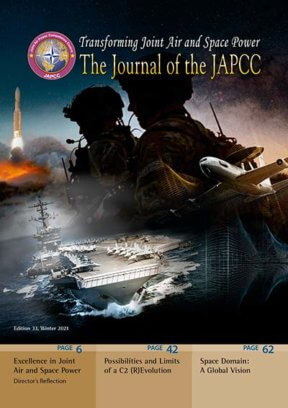Introduction
Space Support plays a significant role in modern warfare and is a key enabler for NATO’s technical advantage. Worldwide technical developments challenge this advantage, while Space has become congested and contested. Consequently, NATO developed an Overarching Space Policy (OSP)1 in 2019, which finally led to the declaration of Space as an operational domain for NATO at the end of that year.2 However, the OSP was classified at the NATO Restricted level and hence, is not available to the media, the public or potential adversaries.
Following Sun Tzu’s famous quote ‘Keep your friends close but your enemies closer’, a publicly available version of the OSP would lead to increased understanding of Allies’ intentions with regard to Space and Space-based capabilities. The decision to keep the OSP classified resulted in media speculation, not only by potential opponents, on the content of this policy.3,4 For this article, the OSP is used as a prominent example of the author’s hypothesis. Most of the arguments used therein apply to other Space-related NATO documents as well.
Why does NATO not continue its reform on strengthening transparency by applying it also to its Space Policy?
Transparency and Deterrence
Transparency and deterrence go hand in hand. It is reasonable to assume that the knowledge concerning potential counteractions, in case of a hostile act, leads to a more sober risk assessment on the side of the aggressor. Additionally, it creates an environment of greater trust between the public and the military/political establishment. NATO has done this in the past by making strategies publicly available, such as the Joint Air Power Strategy5 and the Allied Maritime Strategy.6
Dr Kestutis Paulauskas, a Senior Strategy Officer at NATO Allied Command Transformation and former member of the NATO International Staff, stated ‘The credibility of deterrence – in either of its iterations – rests on a combination of 1) political resolve, 2) capability to inflict pain and 3) clear communication of said resolve and capability.’7 Judging OSP based on this definition, NATO is lacking at least two elements due to the classification and the non-public release of its OSP. The NATO Military Committee meeting, on 14 October 2019, pointed out the relevance of Space in NATO’s defence and deterrence.8
Several NATO nations9 as well as the Russian Federation10 and the People’s Republic of China (PRC)11 have released transparent national Space policies. Neither the PRC nor the Russian Federation are role models for transparency but, due to the relevance of Space to their militaries and economies, they decided to go public with their plans. It is logical to assume that those are sanitized versions for public release. Full versions, for internal use, are presumed to contain parts covering critical information being, for this reason, likely classified.
Is the existence of a classified policy more deterring than a published one?
Classification Issues
There is a need to classify information the deeper it goes into critical planning processes. Documents of this type may include a classified information section, but that does not mean that the entire document has to be classified. NATO classification rules allow for such an apportionment in its policy documents.12 This means that every defined part of a document, whether a paragraph, sentence, or chapter, can get the classification it needs, whilst the rest remains releasable to the public. This way NATO manages its data and information while avoiding over-classification. Structuring a document in this way requires a higher amount of work, because as each section has to be assessed and may have a different classification. However, this extra effort upfront will make the handling and use of the document much easier. Unfortunately, the referenced security guideline identifies this marking as mandatory only for documents classified as confidential or above. Compulsory regulation of documents classified as restricted or even unclassified is not included. The majority of the information in most NATO Unclassified or Restricted documents is publicly available or marked as releasable to the public, so the adaptation of the Allied Command Operations Security Directive to portion-mark documents with these classifications would make them much easier to handle and facilitate appropriate information sharing and interoperability.
Additionally, NATO personnel working with the content of Space policy need clear guidance on what can be publicly discussed and addressed. This is important when personnel contact other experts from industry, media, and the military who are not necessarily cleared for NATO classified documents. When information is over classified and unnecessarily restricted, this can significantly hinder effective collaboration and create scepticism in the minds of partners.
Is it worth saving time in the development phase of a document but lose more time, as well as transparency, in using after its release?
International Recognition and Responses
Acting diametrically opposed to previous transparent policies, classifying of a fundamental document such as the OSP invites speculation and potentially wilful misunderstanding by a potential adversary such as the Russian Federation or PRC. The Russian Federation’s media quoted a Russian Foreign Ministry’s official with a critical statement in response to the declaration of Space as an operational domain.13 Even when NATO Secretary General Jens Stoltenberg’s statement on the declaration was included, it was still a weaker signal than having the chance to present a policy clarifying NATO’s intentions in that domain. Other media reactions on NATO Space activities can be found at Al-Jazeera14 and the Global Times of China.15 These examples start speculation on activities and courses of action that could have indeed been prevented, or at least disproved, with a publicly available policy to present.
Shall NATO set itself up for this kind of media echo without having an available document to disprove misinformation?
Western Think Tank and Media Speculation
The non-profit information service NATO Watch, a critical but not strictly negatively-driven service, aims at improving NATO transparency. In the case of the OSP, the principal critique is that even compared to the United States (US), which had made several national security policies open to the public, NATO does not follow suit. This keeps, by their assessment, the public out of the loop.16
The US news agency Consumer News and Business Channel released an article about the response and fear that the Russian Federation has with NATO activities to treat the Space domain as an operational domain and hence the ‘militarization of space by NATO’. According to the western analysts quoted in the article, most of the fears and assumptions were caused by the lack of information and non-transparency due to the classification of the official source documents.17
Alexandra Stickings, a former Space Security researcher of the Royal United Service Institute, analyses the NATO steps in Space security and speculates about the invocation of Article 5 of the NATO treaty18 in case of an attack against a Space asset operated by one of its member nations.19 She states that due to the classified OSP, this topic is not yet clearly explained by the Alliance. A little more pointed are the complaints about the classified OSP made by Benjamin Silverstein, a research analyst at Carnegie Endowment for International Peace. According to him, the classified policy diminishes NATO’s core security benefits, and that lack of transparency on the question of whether and how NATO’s Article 5 is applicable to Space is of major concern.20
Most of the speculations deal with the topic of the invocation of Article 5 of the NATO treaty. Specifically, in the case of Space, where a potential attack will most likely occur outside of the geographical area defined in Article 6 of the NATO treaty. This can be compared to potential attacks in the Cyber domain, also a NATO operational domain. In this case, the NATO rules are clearly defined and transparent.21
Why is NATO not taking a more proactive approach to stopping these kinds of speculations and assessments on the OSP?
Assessment and Recommendation
NATO should maintain its credibility as a reliable and defensive Alliance that contributes to deterrence through transparency of its source documents. Particularly, in the information age, having official documents available to counter or disprove false or offensive critical statements that may cause further adverse discussions on media or social networks is a benefit. The way NATO approaches the Space topic, using official statements from the Secretary General, is not as assertive as having a policy releasable to the public. Compared to the transparency in Space security provided by many western countries, as well as the Russian Federation and PRC, NATO’s non-transparency leads to unwanted and unneeded speculations and assessments that would otherwise be easily avoided.
Using the classification guidelines more thoroughly and adopting them as mandatory at all classification levels will facilitate better dissemination of the relevant portions of the documents, once released. The ‘easy’, currently in use, way of just classifying the mentioned documents as a whole, leads to over-classification and inhibits cooperation.
Consequently, already existing documents such as the OSP should be reviewed and marked in line with the proposed classification guidelines.
Finally, it is recommended that NATO considers issuing a ‘releasable to the public’ version of the OSP to have a document available to mitigate or rebuff speculation and uninformed critical or false media reports.
That brings us back to Sun Tzu’s quote to:
‘Keep your friends close, but keep your [potential] enemies closer.’












